Moving on in the Genesis Cycle, we come to the second pack, Trace Amounts. This pack continues to expand on the themes presented in the core, as well as adding a few new ones.
Vamp
This card feels very much like a "win more" card, something that is good only while you have the advantage. Because the only time you will be playing this is while you have more credits than the corporation. Plus, you have to get into HQ in order to get the effect of this, so you also have to have enough money to break through all the ice on HQ. Also, this gives you a tag, which is some decks is a good thing, but is bad in others. So you have to juggle a specific set of circumstances in order to make this work. But there are ways to do so.
Trivia: This one is a reprint. The original card out of the Netrunner CCG was called Priority Wreck. It functions the same, but does not give the runner a tag after they spend credits to force the corporation to lose credits.
Pair cards: Account Siphon, Planned Assault
Liberated Account
Similar in effect to Armitage Codebusting from the core set, the card get a lot of money placed on it when installed, and you can pull that money off of it by spending clicks. The big drawback to this is the high install cost, which means you have to invest some time in gaining money to begin with. Also, the return on this is only 10 credits, as opposed to the 11 from Armitage. Still, if you need a lot of credits quickly, this is not a bad way to do so, as it gives 4 credits per click, the same amount as Sure Gamble.
Trivia: There is no direct card from the Netrunner CCG that corresponds with this, but the Proteus expansion had a card named Liberated Savings Account. While the name is similar, it had a different effect. First, it was a hidden resource, which meant it was installed face down, and could be used at almost any time. Second, it cost 7 credits and trashing it to use it, which resulted in gaining 11 credits.
Pair cards: Career Fair
Satellite Uplink
Combining 2 copies of Infiltration into one card, this allows you to determine what 2 installed cards are. That gives you more information out of one click, so you can better plan out future runs. Of course, you have to pay 2 credits for that, but it is a Criminal card, so making money should not be much of a problem.
Trivia: The closest card to this from the original Netrunner CCG would probably be Hunt Club BBS, which exposes up to 3 installed card, but only cost 1 to play.
Pair cards: Blackguard
e3 Feedback Implants
This can be remarkably good. Because several criminal breakers so far have had a cost of 2 credits to break subroutines, this helps offset that cost. If you have to break multiple subroutines, this card allows you to spend one credit to break another subroutine after breaking any one of them. Also, this can be used with other effects that break subroutines. For instance, most bioroid ice allows you to spend clicks to break subroutines. With this, you could spend clicks to break one or more subroutines, and then pay credits to break the rest. Or use this with other cards that break subroutines.
Pair cards: Darwin, Knight, D4v1d, Eater, Endless Hunger, Always Be Running
Compromised Employee
This is an interesting card. One recurring credit that can be used during traces is close to an extra link strength each turn. But perhaps the main benefit is gaining credits whenever the corporation rezzes ice. So if you hold off on running until you have 2 or 3 of these out, you could make some extra money off of the corporation, possibly giving you the boost you need to break their ice. And as an added bonus, if you derez their ice, you could make even more money.
Pair cards: Emergency Shutdown, Crescentus, Muertos Gang Member, Golden, Peregrine, Saker, Exploit
Notoriety
After Global Food Initiative came out, it easily replaced other 3 point agendas in most decks. After all, why not run an agenda that is worth more for you than for the runner? So now the runner has to steal at least 4 agendas to win. But with notoriety, you can win from 6 points by playing this card. Of course, you need to have made a successful run on every central server to play this card, which could take a lot of resources.
Pair cards: Data Dealer, Artist Colony
Snowball
Kind of interesting. This starts fairly weak, but every time it is used to break a subroutine, it gains strength for the rest of the run. So ideally, you want to use it against a server with multiple barrier ice on it. Plus, you would want those barriers to be in optimal order so that you can break all of them while spending the least amount of credits.
Trivia: The original Netrunner CCG did have a card named Snowball, except it costs 10 credits to install, has a base strength of 0, and breaks sentries instead of walls. It does still have that snowballing effect of gaining strength when it breaks subroutines.
Pair cards: Tinkering, Escher, Paintbrush
Dyson Mem Chip
Combining the effects of Akamatsu Mem Chip and Access to Globalsec into one card, Dyson Mem Chip is a good solution for anybody who need some extra memory or link. Of course, this card costs more than the two of those together, but it might be worth it to reduce your deck size.
Pair cards: Modded, Inside Man
Encryption Protocol
A little underwhelming, but there are some possible applications. While one of these alone is easily dealt with, if you could get 2 or 3 in play at the same time, then the trash cost of installed cards becomes harder for the runner to deal with. This might be ideal for an asset spam deck, although most of the already existing asset spam decks use their influence for other cards.
Pair cards: Shipment from MirrorMorph, Turtlebacks, Diversified Portfolio
Sherlock 1.0
This has fairly high strength, which means it will be hard for the runner to deal with in that regard. Of course, as a bioroid, the runner could spend clicks to break the subroutines. But if they are unable to break the subroutines, it means you have an opportunity to disrupt their rig. The base trace strength is 4, so it might only take a few more credits to make it so the runner is unable to match it, but as usual, if the runner has gone with high link strength, this ice may become irrelevant.
Pair cards: Project Wotan, Tyr's Hand, Brain-Taping Warehouse, Wetwork Refit
Jinteki: Replicating Perfection
The new identity for Jinteki is quite a stark difference from Jinteki: Personal Evolution. Now, instead of dealing damage to the runner, the runner becomes unable to run on your remote servers. Of course, if they make a run on one of the central servers first, then they are free to attack your remotes. Still, this does give you a bit of security. If you set up damaging ice on your centrals, you may discourage the runner from being able to run at all, granting you freedom to keep your remotes unprotected. You may still want to set up a scoring server, however, as they may decide it is worth the risk if they figure out you are keeping agendas in the open.
Trivia: This identity is sometimes referred to as "White Tree," as it is a close negative to Personal Evolution, which is sometimes referred to as "Black Tree."
Pair cards: Sundew, Clone Suffrage Movement, Bio-Ethics Association, Sensie Actors Union, Commercial Bankers Group
Fetal AI
A 5 advancement requirement for only 2 points does not seem to be very good, but the main benefit to this card is in the ability. When the runner accesses this card, you will do 2 net damage to them, unless it was in Archives. That 2 damage can be fairly significant, especially if you are playing Personal Evolution, because they may be unable or unwilling to steal it and take more damage. Plus, the runner also has to pay 2 credits to steal it, meaning if they burnt through all of their credits breaking into the server, they then took damage for nothing.
Trivia: Another reprint. The Proteus expansion to the Netrunner CCG has a card named Fetal AI, with the exact same effects and advancement requirement, although it is worth 3 agenda points.
Pair cards: Red Herrings, Strongbox, Mushin No Shin
Trick of Light
So suppose you put out a trap such as Project Junebug and put up a few counters on it. But the runner chooses not to run on it, or exposes it and knows not to run on it. If you only had the core, then you would have wasted your time and money. But with this card, you could transfer those counters off of the trap onto another card that can be advanced, such as an agenda. With four counters in play and two copies of this, you could install a 4 advancement requirement agenda and score it in the same turn. While that does seem to be the main benefit of this card, you could use it in other ways.
Trivia: Close to a reprint. There is a card out of the original Netrunner CCG called Falsified-Transactions Expert which is almost the same, except it allows you to move up to 3 advancement counters from one card to another.
Pair cards: ice that can be advanced, Ronin, Thomas Haas, GRNDL Refinery, Mushin No Shin, Contract Killer
Sensei
A fairly cheap piece of ice that does not seem much play. It is porous, but its one subroutine is interesting. If it goes off, then all other pieces of ice encountered in the run gain an extra "end the run" subroutine. That could make the run much more expensive for the runner. Or they may decide to break this in order to save on that cost. Still, it is very dependent on placement.
Trivia: Another card that is almost a reprint. The original Netrunner CCG has a card called Tutor, which is almost the same, but has a rez cost of 4 instead.
Pair cards: Sunset, Tenma Line
Big Brother
A fairly simple card. If you manage to land a tag on the runner, then this card can give them 2 more tags, meaning they will probably have to spend more money to remove those tags, or just live with having a lot of tags. I suppose the big trick is getting the first tag in the first place, but there are way to do that easily enough.
Trivia: Obviously a reference to George Orwell's novel 1984, but also a reprint. The original card from the Netrunner CCG was called Datapool® by Zetatech, and had the same effect, but cost 1 credit to play.
Pair cards: Breaking News, Psychographics, SEA Source, Midseason Replacements, Lily Lockwell, Keegan Lane
ChiLo City Grid
Being moderately expensive to rez, this upgrade has an interesting ability. Every time there is a successful trace during a run on the server, you give the runner a tag. So if you can load up a lot of tracer ice on a server with this, you could possibly land a large number of tags on the runner. Of course, those traces have to be successful, so there is that.
Triva: ChiLo is a megapolis reaching from Chicago to St. Louis. Apparently, the mayor has decreed that citizenship is open to anyone, although you'll have to pay quite a price to afford it.
Pair cards: An Offer You Can't Refuse, Improved Tracers
Power Grid Overload
A possible solution to pesky hardware. If the trace succeeds, then you can trash a piece of hardware with an install cost less than or equal to the amount by which the trace succeeded. But the initial trace strength is low, which means you may need to invest a significant amount of cash into boosting the trace. Plus, if the runner pours in the credits, you might not be able to trash anything they have. Still, forcing the runner to spend their credits to keep their gear could open up a scoring window.
Trivia: A reprint, of sorts. The original Netrunner CCG has a card named Power Grid Overload, but in order to use it, the runner has to be tagged. Also, it allows you to trash a number of pieces of non-cyberware hardware equal to the amount you spend on the card.
Pair cards: NBN: Making News, Primary Transmission Dish
Amazon Industrial Zone
This card is fairly expensive, but could save you money in the long term. If you can install at least 2 piece of ice with the reduced cost, then you have potentially saved 2 credits, and may have saved 3 more credits for each additional installation after that. But it feels like you have to protect this card in the first place before you can get any use out of it. Add in the low trash cost, and it looks like there are better regions to use. Still, there are a few cards that do benefit from this effect.
Pair cards: Woodcutter, Tyrant, Salvage
Executive Retreat
Rather interesting. Scoring this forces you to shuffle all cards into your hand back into your deck, but you get a counter on this that you can use along with a click to draw five cards. Basically, this allows you to reset your hand if you do not like your cards, or it could allow you to get a lot of cards at once.
Trivia: Remarkably, this card is a reprint. The original card from the Netrunner CCG was called AI Chief Financial Officer, which had the same effect, except you shuffled your hand back into your deck when you used it instead of when you scored it. Also, it was only worth 2 agenda points.
Freelancer
So if your opponent is playing a lot of resource, it could be expensive to try and trash them all once you have them tagged. Or instead, you could play this card, which can trash up to 2 resources. With a play cost of 0, you just saved 4 credits, meaning those credits can be better utilized for rezzing ice, advancing agendas, or could be spent to trash more resources.
Pair cards: Breaking News, SEA Source, Midseason Replacements
And that is all for Trace Amounts. Next time, we take a look at Cyber Exodus.
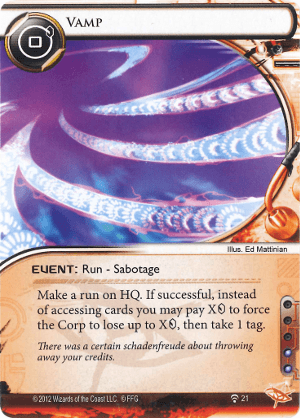
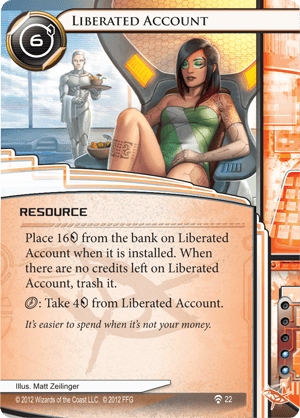
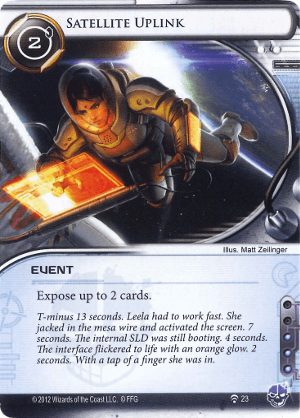
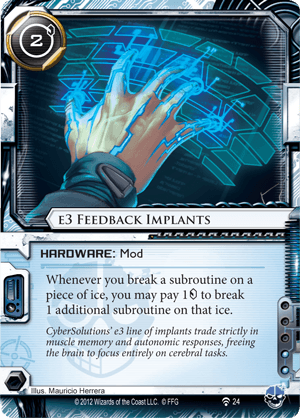
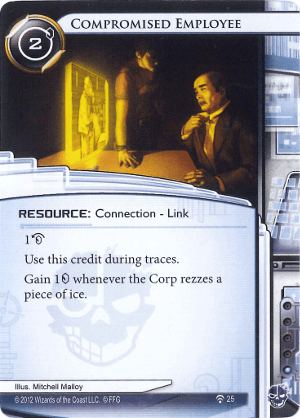

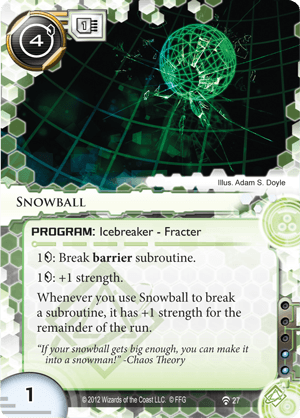
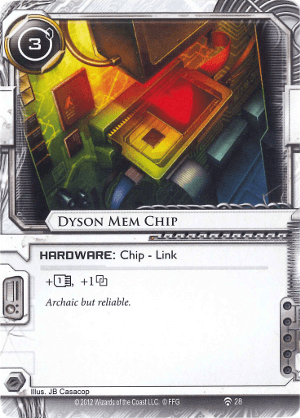
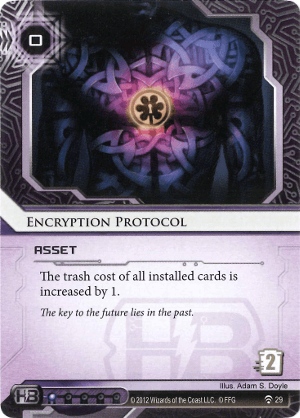
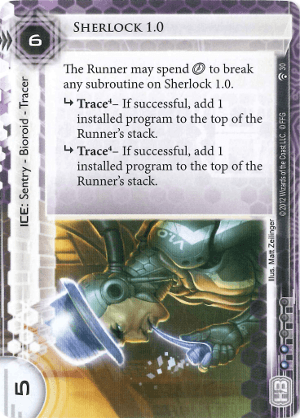
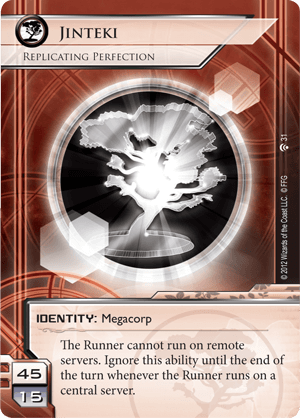
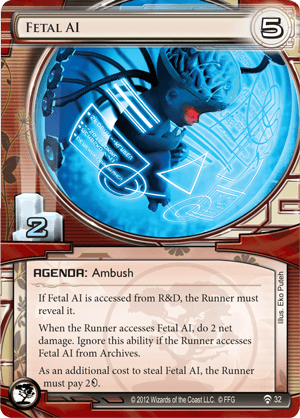
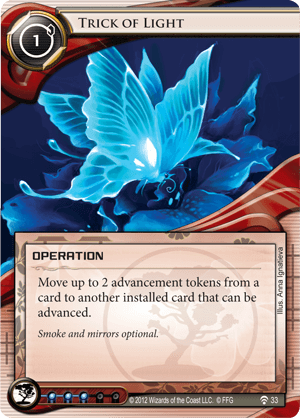
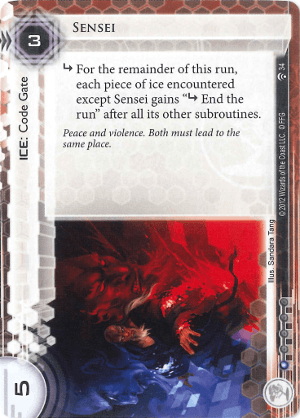
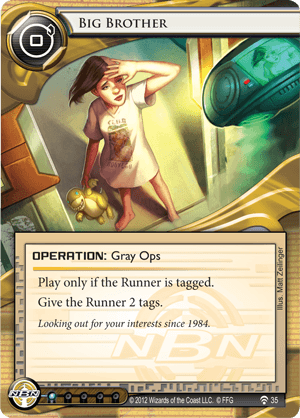
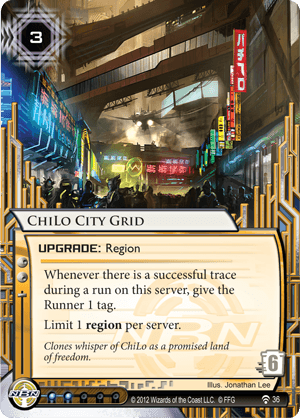
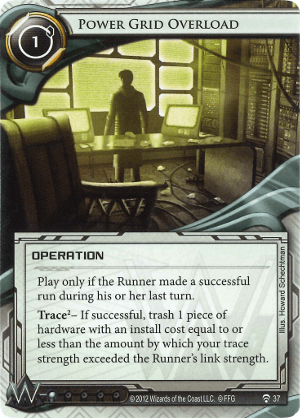
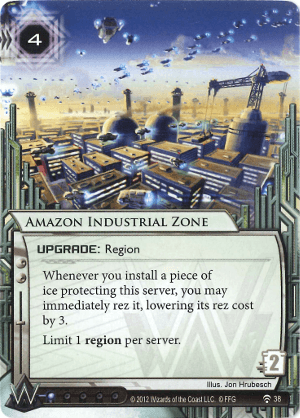
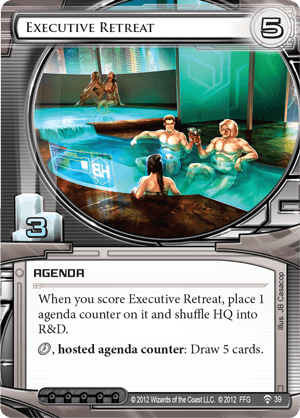
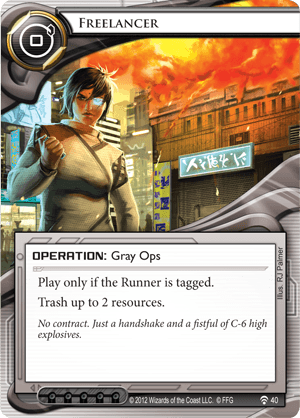
No comments:
Post a Comment